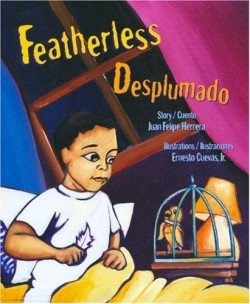Desplumado
“He was born a little different, like you were,” Papi whispers as he pours some water for the little bird. “Not like me,” Tomasito responds. “He doesn’t have spina bifida! And he’s featherless!” This book tells the uplifiting story of one boy’s struggle to fit in and feel normal in a new town, while restricted to a wheelchair. Having moved from Mendota to Fresno, Tomasito finally makes a new friend in class, Marlena. With the encouragement of his new friend, his Papi, and his featherless bird, Tomasito eventually adjusts to the new location, and becomes comfortable with himself. He even becomes a star soccer player. “Toma-sito! Toma-sito!” The crowd cheers, “Goooooooooal!” Tomasito feels free and like he is flying when he is playing soccer. With his new positive attitude he encourages his featherless and flightless bird to find his own way to fly.
An acclaimed poet and winner of the Ezra Jack Keats Award, the author teaches at California State University in Fresno and has written more than a dozen children’s books. One of his previous works, The Upside-Down Boy, was recently made into a musical for children.
The illustrator has a successful graphic design business in Atlanta, Georgia. His love of Chicano culture and history are evident in his acrylic illustrations—the vivid red-orange of the sunshine, the bold blues and purples of the walls, and the vegetable-green grass. Cuevas captures the moods of the book’s characters in their body language, which adds to the already present emotion in the story. Readers might be inclined to pout along with Tomasito at the start of the story and cheer along with him at its conclusion.
A heartening story, Desplumado is written for children eight to ten years old. This bilingual children’s book is a thoughtful story that may well aid in the opening of young minds. Skillfully translated, the text contains fun sound-effect words such as “Pop-pop-zaz” and “¡Tilín!, ¡Tilín!, ¡Tilín!, ¡Tilín!” that add a feeling of presence and participation in the story. This book belongs in the collections of people who care about others and who wish to inform. At its conclusion there is a two-paragraph bit of information on spina bifida along with a web address.
Disclosure: This article is not an endorsement, but a review. The publisher of this book provided free copies of the book to have their book reviewed by a professional reviewer. No fee was paid by the publisher for this review. Foreword Reviews only recommends books that we love. Foreword Magazine, Inc. is disclosing this in accordance with the Federal Trade Commission’s 16 CFR, Part 255.

